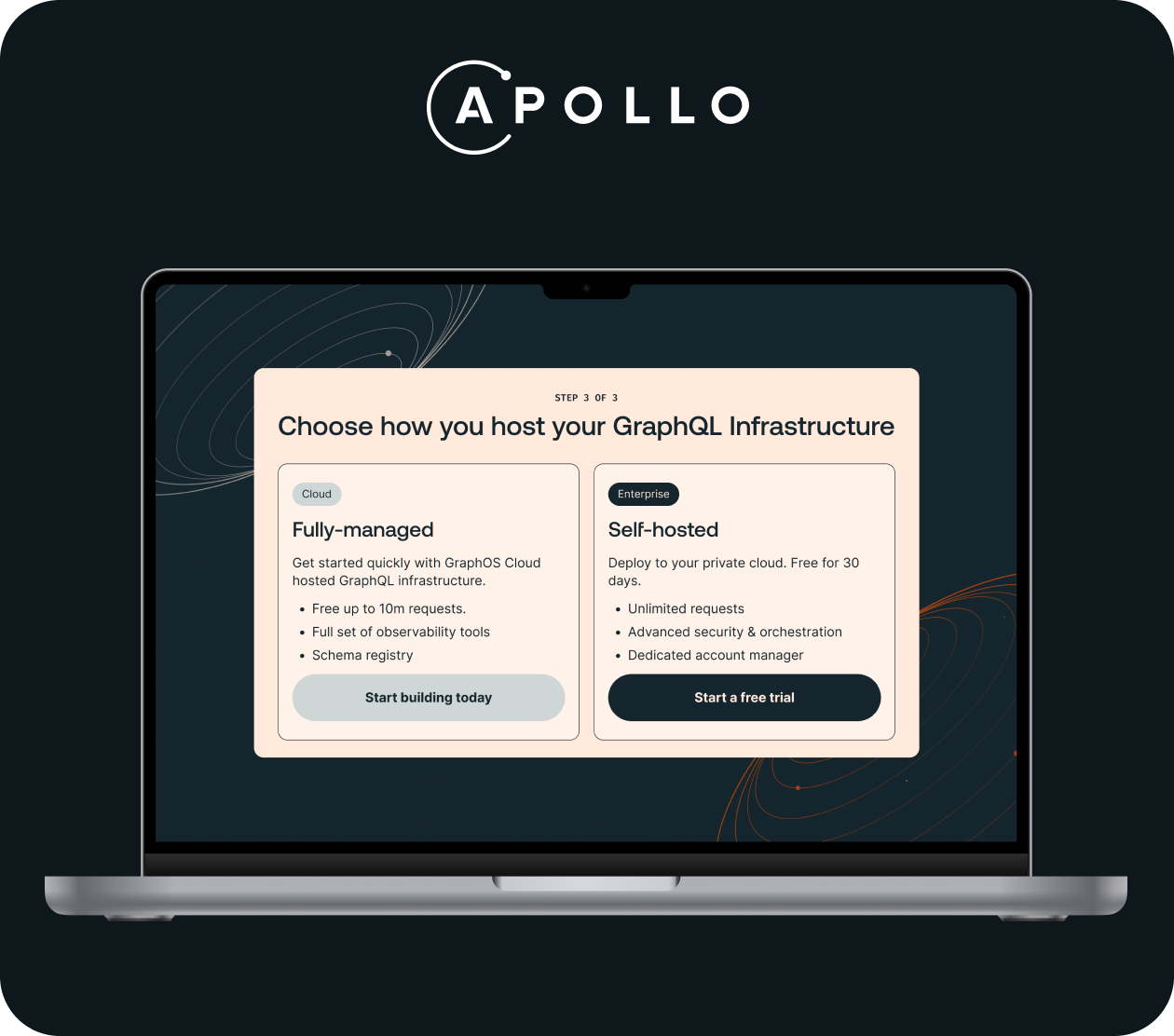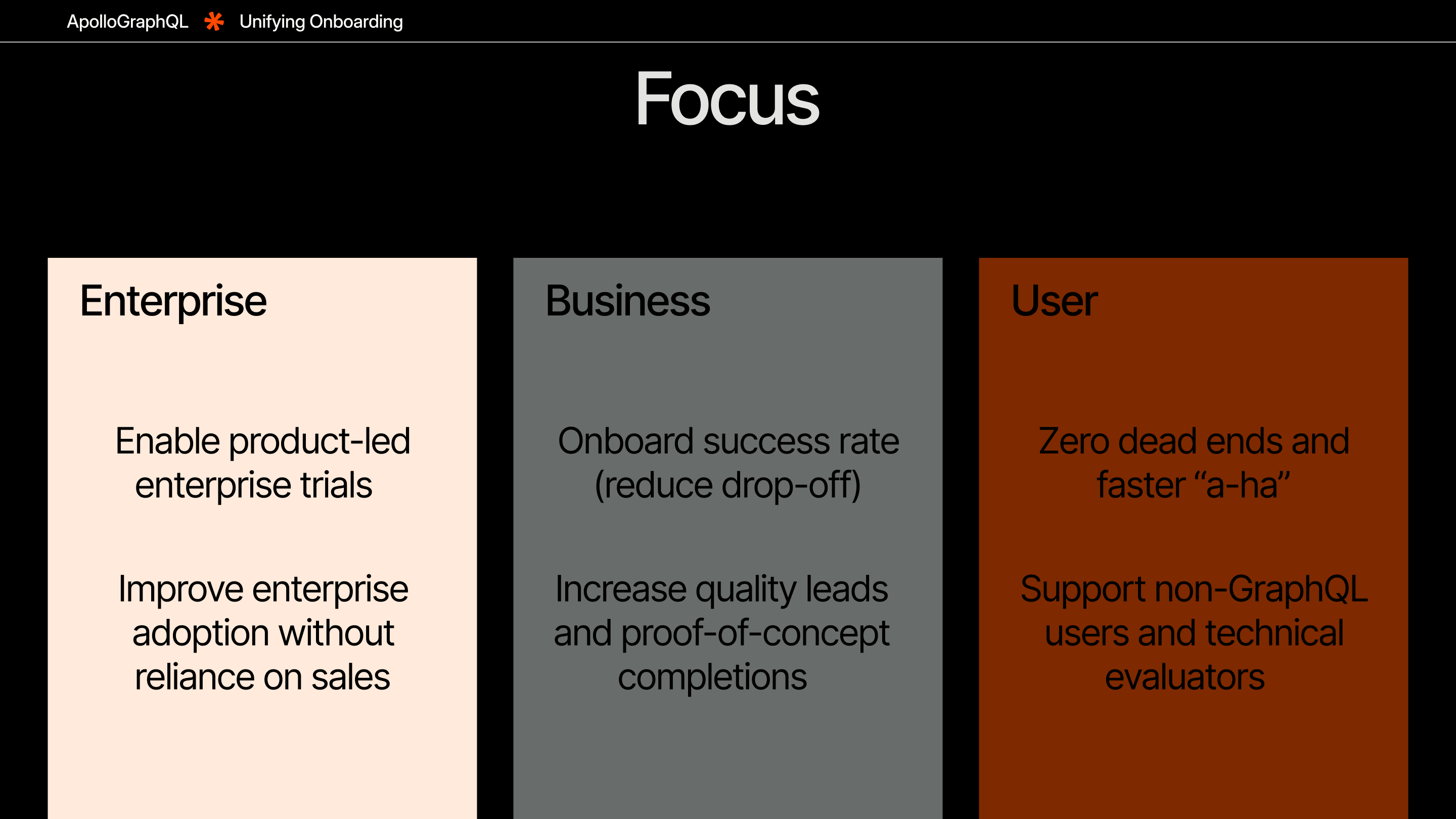Tripling enterprise trial sign-ups with Apollo's first self-serve product plan
I led the design of Apollo’s first enterprise self-serve funnel, enabling teams to demo, trial, and upgrade without needing sales intervention.

Overview
I led the design of Apollo’s first enterprise self-serve funnel, enabling large organizations to explore, trial, and activate GraphOS without requiring sales intervention. This work tripled enterprise trial sign-ups, improved activation, and shifted Apollo’s positioning from “not secure enough” to “enterprise-ready.” Our target user is a tech lead at a large company with lots of APIs. She needs a quick, low-risk way to see value and a path she can share with her team. Users within our ICPs role are typically dealing with ‘spaghetti’ REST APIs and looking for a way to consolidate APIs with governance.
What is ApolloGraphQL?
Apollo is the creator of GraphOS, a platform for building, managing, and scaling GraphQL APIs. Enterprise adoption of GraphOS required trust, security, and scalability, but Apollo’s original onboarding flow worked against those needs.
The old funnel forced users to provide sensitive API credentials up front and silently routed everyone into a free serverless plan. This excluded over 60% of incoming users, created a 92% drop-off rate, and hid the enterprise-level capabilities evaluators actually cared about: private setup, security posture, governance, and advanced controls.
At the same time, Apollo needed to test if self-serve could capture enterprise buyers at scale while reducing the cost of sales-assisted onboarding.

Problem
Apollo’s revenue is driven by enterprise contracts, so letting enterprise evaluators self-start mattered. The original onboarding everyone was quietly routed into the free Serverless flow. That hid the things enterprises actually evaluate—private setup, security posture, and advanced controls—and it created day-one friction with security and platform teams.
- Trust gap at the gate: “What does Apollo access? Is my data compliant/safe?”
- Day-one misalignment: Enterprise users were forced into a “free” path that wasn’t relevant to their evaluation.
- Scalability limits: A sales-led approach couldn’t handle growing enterprise demand.
Opportunity
Reframe onboarding from a generic UI flow into a strategic entry point for enterprise growth by:
- Giving evaluators a path to trial GraphOS Enterprise on their own.
- Surfacing the features they actually needed to validate (private graphs, regional hosting, security controls).
- Capturing cleaner product signals to improve Sales prioritization.
This would enable:
- Right tool, right away: Enterprise users aren’t evaluating “free", they’re validating private, secure, scalable. Starting in the wrong plan creates false negatives.
- Faster proof-of-value: Champions can show a working demo to leadership without Sales in the loop.
- Cleaner signals: Plan choice + feature usage tell us who’s truly enterprise, improving lead quality and prioritization for Sales.
Goals
- Business: Increase quality leads, reduce sales overhead.
- Enterprise: Enable self-serve 30-day trials, improve enterprise adoption without mandatory sales touch.
- User: Deliver a faster path to proof-of-value, while building trust and transparency around data use.
My role
Staff Product Designer, responsible for end-to-end design of the new funnel and its cross-functional rollout. I partnered with:
- Growth & Product leads — to align revenue goals and ensure trials were qualified.
- Head of Marketing — to align blog + web messaging.
- Head of Content & Learning — to produce support/training documentation.
- Head of Sales — to communicate changes to sales processes and expectations.
The process
I approached this problem like any complex enterprise challenge: by breaking it down into layers of user trust, business viability, and technical feasibility.
- Mapped the journey: Audited the existing funnel, ran user journey mapping workshops, and highlighted drop-off points (92% at API gate).
- Gathered evidence: Partnered with growth to analyze sign-up data, and interviewed enterprise evaluators to understand why trust broke down.
- Framed opportunity areas: Identified three levers — defer sensitive asks, introduce tier choice upfront, and create modular demo/learning paths.
- Iterated prototypes: Tested low-fi prototypes with developers and enterprise champions, validating clarity and compliance language before final design.
- Cross-functional rollout: Coordinated with marketing, content, and sales so product, messaging, and training aligned on day one.
This mix of quantitative signals (drop-offs, trial activations) and qualitative insights (interviews, feedback loops) ensured the new funnel was not just smoother, but also strategically positioned to serve both developers and Apollo’s enterprise sales motion.
Solution
From the user perspective:
- Deferred sensitive asks until after context was established.
- Added clear explanations of data handling and compliance.
- Redesigned org creation with a pricing tier selector so users could choose an enterprise trial from day one.
- Updated visuals and tone as part of Apollo’s rebrand.
- Added an opt-in research program to collect future feedback.
From the business perspective:
- Balanced SOC 2 compliance with transparency.
- Built modular demo paths tailored to developers vs. product leaders.
- Created a self-serve 30-day enterprise trial path that scaled without full sales involvement.
- Coordinated cross-functionally so the funnel was supported in marketing, sales, and success workflows.
Outcomes
Learnings
- Enterprise evaluators expect to validate proof-of-concept within onboarding, not weeks later.
- Starting evaluators in the wrong plan creates false negatives that kill deals.
- Plan choice + feature usage are powerful lead-quality signals for Sales.
This work reframed how Apollo could reach and retain enterprise customers through product-led growth. By creating a trustworthy, self-serve enterprise path, we gave developers a way to prove value without sales in the loop, and gave Apollo a repeatable model for capturing qualified enterprise demand at scale.
Previous designs








